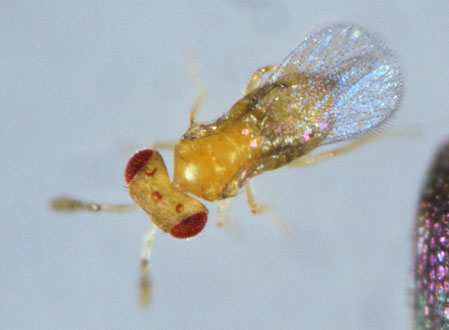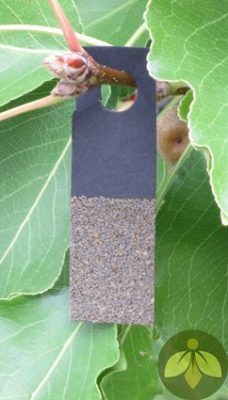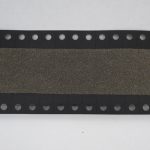General

TRICHOforce™ are parasitoids capable of moth and caterpillar control. The eggs of over 150 species of moths can be parasitized by Trichogramma. TRICHOforce™ are shipped as pre-parasitized, ready-to-emerge flour moth eggs (Ephestia kuehniella) placed on a card perforated into 30 squares.
- TRICHOforce™ B (Trichogramma brassicae) This is the ideal product when targeting the eggs of moths whose larvae are pests of cole crops as well as the European Corn Borer (Ostrinia nubilalis).
- TRICHOforce™ PL (Trichogramma platneri) or TRICHOforce™ M (Trichogramma minutum) This is the ideal product for moth control in orchards or tall crop settings.
Some popular hosts of TRICHOforce™ include the eggs of: codling moth (Cydia pomonella); diamondback moth (Plutella xylostella); Oriental fruit moth (Graphiolitha molesta); tomato pinworms (Keiferia lycopersicella); cabbage loopers (Trichoplusia ni); imported cabbage worms (Pieris rapae); tent caterpillars (Malacosoma spp.); and many, many more, even the grossly damaging tobacco/tomato hornworms (Manduca spp.).
Life-History

TRICHOforce™, as parasitoids, work by laying eggs in the eggs of many Lepidopteran spp (moths and butterflies). The adult wasps can lay up to 300 eggs each, parasitizing an equivalent number of soon-to-be destructive caterpillars, loopers and/or worms.The wasps’ larvae hatch from the eggs, attack the moths’ eggs’ embryos from within (endoparasitism). Instead of pests hatching out, more mini-wasps emerge instead. The lifespan of these parasitoids is roughly 7 days in their immature stages, then up to 10 days as adults. With such a short life-cycle, these parasitoids can sometimes build up to 30 generations per year (many of which over winter). The conditions for optimum caterpillar control and moth control will be between 70-85°F with a relative humidity of around 60%. But these are optimum conditions, and not necessarily essential for success. Please note, however, significantly cooler or warmer temperatures and humidity fluctuations may hamper reproduction and development of the Trichogramma to a certain degree.
Benefits
These wasps are cheap, easy, and effective at controlling both caterpillars and moths. Because these parasitoids are supplied on cards that are perforated into squares, even distribution is a sure thing.
Drawbacks
The one downfall for these parasitoids are ants; they love Trichogramma eggs and will rob them from the squares. Therefore creativity is sometimes necessary: stapling the squares to leaves, attaching them to a tree trunk and surrounding the small area with a sticky barrier product may help ward off the ants. Another option is to pre-emerge the eggs by allowing the cards to remain in the bags they’re shipped in and wait for emergence, checking the bags at least once daily. When the first sign of emerged parasitoids is evident, hang the cards and shake out the wasps in the bags. This will reduce the amount of time the eggs on the cards are exposed and threatened by marauding ants. Also, you must really know the pest you’re dealing with as timing is critical in many cases. The pests’ eggs have to be available, and one sure way to guarantee this is to know when they are being deposited. TRICHOforce™ is only a preventive weapon for caterpillar and moth control, but they can’t parasitize the pests’ eggs once they hatch into larvae.
Scouting
Seeing TRICHOforce™ at work is normally out of the question. They’re just too small and quick. If you can find the moth eggs, you may be able to determine if they have exit holes from the wasps. The only other indicator is fewer caterpillars upon their hatch, and less damage noticed shortly thereafter. Some caterpillar pests are more difficult to control than others. This can be a drawback, especially if the tough-to-kill pest is a serious pest. With this known, the implementation of multiple Integrated Pest Management (IPM) resources is necessary. Unfortunately, this costs time and money. Battling ants, which are a real threat to biocontrol when it comes to these wasps, is sometimes very difficult, too. It adds complexity to the would-be simple implementation of these parasitoids used for caterpillar control and moth control.
Usages
Greenhouses and interiorscapes have employed these wasps successfully. Mainly, however, these parasitoids are used for caterpillar control in field and row crops, orchards, and gardens.
Release Rates for TRICHOforce™
| Classification | Release Information |
|---|---|
| General | 1-2 per square feet/weekly during moth flight |
| Acre+ | 50,000 to 100,000 per acre/weekly during moth flight |
| Comments | Timing is critical to ensure host eggs are available for parasitism. |

